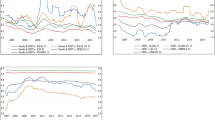Abstract
Futures contracts often contain several different kinds of embedded options related to the delivery of the underlying. The end of the month option allows the holder of the short end of a futures contract to deliver the underlying at any time during the last week of the contract period at a fixed price determined at the start of the last week. We derive a formula for this price in a general incomplete financial market, in which the process underlying the futures contract is a general adapted càdlàg process and the risk free interest rate process is a general adapted process, both satisfying certain integrability conditions. In a similar setting we also derive a formula for the futures price process of a futures contract which first has no option active, then it has an active timing option (which lets the holder of the short end deliver at any time during the last month of the contract period) and lastly it has an active end of the month option. This combination of delivery options is present in the real-world financial markets. We show that this futures price process is dominated by a standard futures price process with maturity at the time of the activation of the end of the month option. We also show that if the underlying is an asset with a non-positive convenience yield and the interest rate is non-negative then it is optimal to deliver when the end of the month option becomes active. The main contribution of this paper is to properly define the end of the month option and to derive a formula for the futures price process of a futures contract with the combination of options described above.
Similar content being viewed by others
Notes
It is easy to see that Assumption 2.1 provides sufficient regularity for this proof.
The assumption that \(r \ge 0\) can easily be relaxed to \(\sup _{T_{e}\le \tau \le T} E_{\mathcal {F}_{T_{e}}}^{Q}\left[ e^{-\int _{T_{e}}^{\tau }r_sds} \right] \le 1\).
\(F_{e} > 0 \) by (2), since \(X>0\) in this example.
The existence of such a process F is an assumption on X and r, which is clear from Proposition 4.6 and its proof.
References
Biagini, F., & Björk, T. (2007). On the timing option in a futures contract. Mathematical Finance, 17(2), 267–283.
Björk, T. (2009). Arbitrage theory in continuous time (3rd ed.). Oxford: Oxford University Press.
Boyle, P. P. (1989). The quality option and timing option in futures contracts. Journal of Finance, 44(1), 101–113.
Chen, R. R., & Yeh, S. K. (2012). Analytical bounds for treasury bond futures prices. Review of Quantitative Finance and Accounting, 39(2), 209–239.
Cohen, H. (1995). Isolating the wild card option. Mathematical Finance, 5(2), 155–165.
Fakeev, A. G. (1970). Optimal stopping rules for stochastic processes with continuous parameter. Theory of Probability & Its Applications, 15(2), 324–331.
Gay, G. D., & Manaster, S. (1984). The quality option implicit in futures contracts. Journal of Financial Economics, 13(3), 353–370.
Gay, G. D., & Manaster, S. (1986). Implicit delivery options and optimal delivery strategies for financial futures contracts. Journal of Financial Economics, 16(1), 41–72.
Karatzas, I., & Shreve, S. E. (1998). Methods of mathematical finance. Berlin: Springer.
Karatzas, I., & Shreve, S. E. (1991). Brownian motion and stochastic calculus. Berlin: Springer.
Author information
Authors and Affiliations
Corresponding author
Additional information
Financial support from the Tom Hedelius and Jan Wallander Foundation and The Fund Carl Silfvén is gratefully acknowledged. The author is also grateful to Professor Tomas Björk for helpful comments on this paper.
Rights and permissions
About this article
Cite this article
Lindensjö, K. The End of the Month Option and Other Embedded Options in Futures Contracts. Asia-Pac Financ Markets 23, 69–83 (2016). https://doi.org/10.1007/s10690-016-9209-7
Published:
Issue Date:
DOI: https://doi.org/10.1007/s10690-016-9209-7




